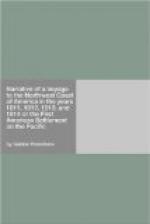with the indigence and uncleanliness of its inhabitants;
and I regretted that it had not fallen to the lot of
civilized men. I was wrong no doubt: it is
just that those should be most favored by their common
mother, who are least disposed to pervert her gifts,
or to give the preference to advantages which are factitious,
and often very frivolous. We quitted with regret
this charming spot, and soon came to another large
village, which our guide informed us was called
Kathlapootle,
and was situated at the confluence of a small stream,
that seemed to flow down from the mountain covered
with snow, which we had seen the day before:
this river is called
Cowilkt. We coasted
a pretty island, well timbered, and high enough above
the level of the Columbia to escape inundation in
the freshets, and arrived at two villages called
Maltnabah.
We then passed the confluence of the river
Wallamat,
or
Willamet, above which the tide ceases to
be felt in the Columbia. Our guide informed us
that ascending this river about a day’s journey,
there was a considerable fall, beyond which the country
abounded in deer, elk, bear, beaver, and otter.
But here, at the spot where we were, the oaks and
poplar which line both banks of the river, the green
and flowery prairies discerned through the trees, and
the mountains discovered in the distance, offer to
the eye of the observer who loves the beauties of
simple nature, a prospect the most lovely and enchanting.
We encamped for the night on the edge of one of these
fine prairies.
On the 7th we passed several low islands, and soon
discovered Mount Hood, a high mountain, capped
with snow, so named by Lieutenant Broughton; and Mount
Washington, another snowy summit, so called by
Lewis and Clarke. The prospect which the former
had before his eyes at this place, appeared to him
so charming, that landing upon a point, to take possession
of the country in the name of King George, he named
it Pointe Belle Vue. At two o’clock
we passed Point Vancouver, the highest reached
by Broughton. The width of the river diminishes
considerably above this point, and we began very soon
to encounter shoals of sand and gravel; a sure indication
that we were nearing the rapids. We encamped
that evening under a ledge of rocks, descending almost
to the water’s edge.
The next day, the 8th, we did not proceed far before
we encountered a very rapid current. Soon after,
we saw a hut of Indians engaged in fishing, where
we stopped to breakfast. We found here an old
blind man, who gave us a cordial reception. Our
guide said that he was a white man, and that his name
was Soto. We learned from the mouth of
the old man himself, that he was the son of a Spaniard
who had been wrecked at the mouth of the river; that
a part of the crew on this occasion got safe ashore,
but were all massacred by the Clatsops, with the exception
of four, who were spared and who married native women;




